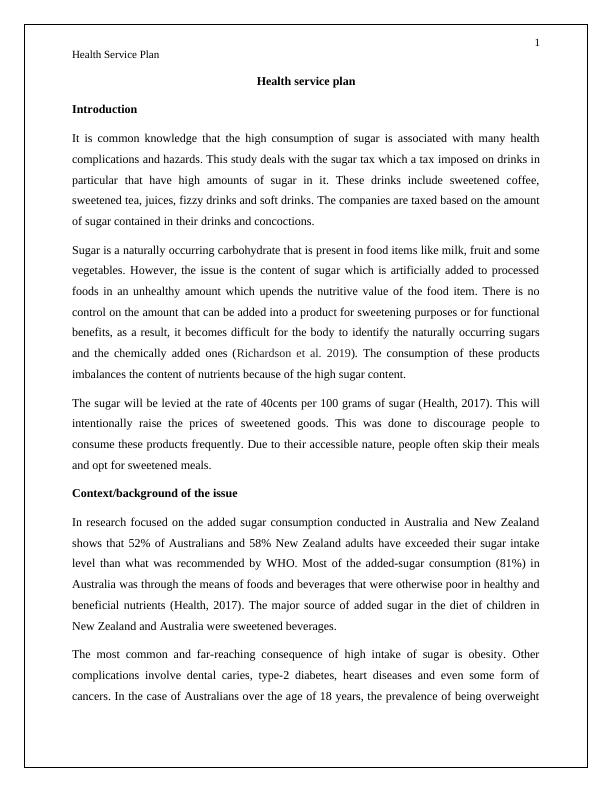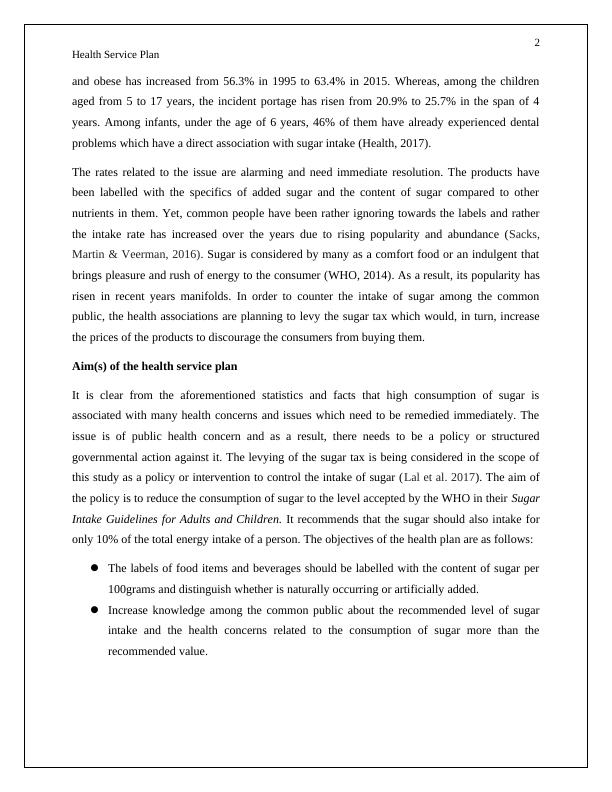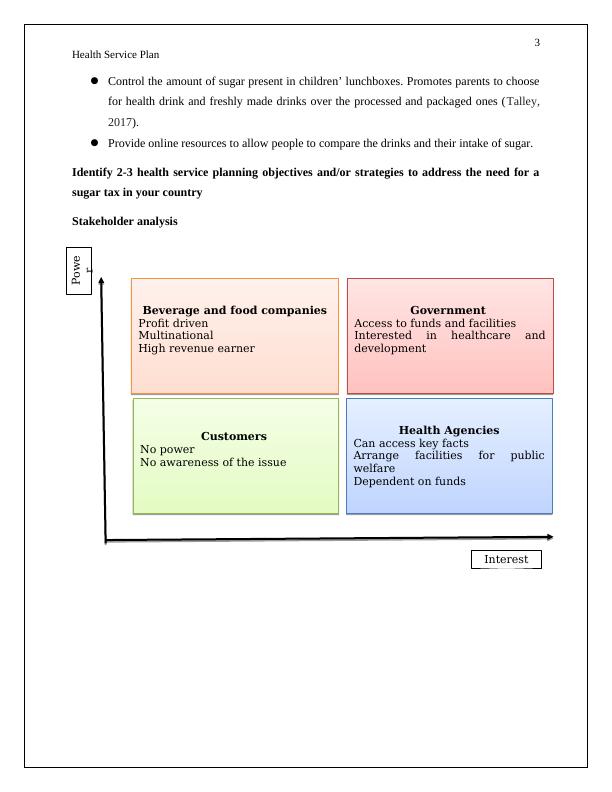Sugar Tax: A Health Service Plan to Control Sugar Intake
Added on 2022-11-13
9 Pages2996 Words91 Views
1
Health Service Plan
Health service plan
Introduction
It is common knowledge that the high consumption of sugar is associated with many health
complications and hazards. This study deals with the sugar tax which a tax imposed on drinks in
particular that have high amounts of sugar in it. These drinks include sweetened coffee,
sweetened tea, juices, fizzy drinks and soft drinks. The companies are taxed based on the amount
of sugar contained in their drinks and concoctions.
Sugar is a naturally occurring carbohydrate that is present in food items like milk, fruit and some
vegetables. However, the issue is the content of sugar which is artificially added to processed
foods in an unhealthy amount which upends the nutritive value of the food item. There is no
control on the amount that can be added into a product for sweetening purposes or for functional
benefits, as a result, it becomes difficult for the body to identify the naturally occurring sugars
and the chemically added ones (Richardson et al. 2019). The consumption of these products
imbalances the content of nutrients because of the high sugar content.
The sugar will be levied at the rate of 40cents per 100 grams of sugar (Health, 2017). This will
intentionally raise the prices of sweetened goods. This was done to discourage people to
consume these products frequently. Due to their accessible nature, people often skip their meals
and opt for sweetened meals.
Context/background of the issue
In research focused on the added sugar consumption conducted in Australia and New Zealand
shows that 52% of Australians and 58% New Zealand adults have exceeded their sugar intake
level than what was recommended by WHO. Most of the added-sugar consumption (81%) in
Australia was through the means of foods and beverages that were otherwise poor in healthy and
beneficial nutrients (Health, 2017). The major source of added sugar in the diet of children in
New Zealand and Australia were sweetened beverages.
The most common and far-reaching consequence of high intake of sugar is obesity. Other
complications involve dental caries, type-2 diabetes, heart diseases and even some form of
cancers. In the case of Australians over the age of 18 years, the prevalence of being overweight
Health Service Plan
Health service plan
Introduction
It is common knowledge that the high consumption of sugar is associated with many health
complications and hazards. This study deals with the sugar tax which a tax imposed on drinks in
particular that have high amounts of sugar in it. These drinks include sweetened coffee,
sweetened tea, juices, fizzy drinks and soft drinks. The companies are taxed based on the amount
of sugar contained in their drinks and concoctions.
Sugar is a naturally occurring carbohydrate that is present in food items like milk, fruit and some
vegetables. However, the issue is the content of sugar which is artificially added to processed
foods in an unhealthy amount which upends the nutritive value of the food item. There is no
control on the amount that can be added into a product for sweetening purposes or for functional
benefits, as a result, it becomes difficult for the body to identify the naturally occurring sugars
and the chemically added ones (Richardson et al. 2019). The consumption of these products
imbalances the content of nutrients because of the high sugar content.
The sugar will be levied at the rate of 40cents per 100 grams of sugar (Health, 2017). This will
intentionally raise the prices of sweetened goods. This was done to discourage people to
consume these products frequently. Due to their accessible nature, people often skip their meals
and opt for sweetened meals.
Context/background of the issue
In research focused on the added sugar consumption conducted in Australia and New Zealand
shows that 52% of Australians and 58% New Zealand adults have exceeded their sugar intake
level than what was recommended by WHO. Most of the added-sugar consumption (81%) in
Australia was through the means of foods and beverages that were otherwise poor in healthy and
beneficial nutrients (Health, 2017). The major source of added sugar in the diet of children in
New Zealand and Australia were sweetened beverages.
The most common and far-reaching consequence of high intake of sugar is obesity. Other
complications involve dental caries, type-2 diabetes, heart diseases and even some form of
cancers. In the case of Australians over the age of 18 years, the prevalence of being overweight

2
Health Service Plan
and obese has increased from 56.3% in 1995 to 63.4% in 2015. Whereas, among the children
aged from 5 to 17 years, the incident portage has risen from 20.9% to 25.7% in the span of 4
years. Among infants, under the age of 6 years, 46% of them have already experienced dental
problems which have a direct association with sugar intake (Health, 2017).
The rates related to the issue are alarming and need immediate resolution. The products have
been labelled with the specifics of added sugar and the content of sugar compared to other
nutrients in them. Yet, common people have been rather ignoring towards the labels and rather
the intake rate has increased over the years due to rising popularity and abundance (Sacks,
Martin & Veerman, 2016). Sugar is considered by many as a comfort food or an indulgent that
brings pleasure and rush of energy to the consumer (WHO, 2014). As a result, its popularity has
risen in recent years manifolds. In order to counter the intake of sugar among the common
public, the health associations are planning to levy the sugar tax which would, in turn, increase
the prices of the products to discourage the consumers from buying them.
Aim(s) of the health service plan
It is clear from the aforementioned statistics and facts that high consumption of sugar is
associated with many health concerns and issues which need to be remedied immediately. The
issue is of public health concern and as a result, there needs to be a policy or structured
governmental action against it. The levying of the sugar tax is being considered in the scope of
this study as a policy or intervention to control the intake of sugar (Lal et al. 2017). The aim of
the policy is to reduce the consumption of sugar to the level accepted by the WHO in their Sugar
Intake Guidelines for Adults and Children. It recommends that the sugar should also intake for
only 10% of the total energy intake of a person. The objectives of the health plan are as follows:
The labels of food items and beverages should be labelled with the content of sugar per
100grams and distinguish whether is naturally occurring or artificially added.
Increase knowledge among the common public about the recommended level of sugar
intake and the health concerns related to the consumption of sugar more than the
recommended value.
Health Service Plan
and obese has increased from 56.3% in 1995 to 63.4% in 2015. Whereas, among the children
aged from 5 to 17 years, the incident portage has risen from 20.9% to 25.7% in the span of 4
years. Among infants, under the age of 6 years, 46% of them have already experienced dental
problems which have a direct association with sugar intake (Health, 2017).
The rates related to the issue are alarming and need immediate resolution. The products have
been labelled with the specifics of added sugar and the content of sugar compared to other
nutrients in them. Yet, common people have been rather ignoring towards the labels and rather
the intake rate has increased over the years due to rising popularity and abundance (Sacks,
Martin & Veerman, 2016). Sugar is considered by many as a comfort food or an indulgent that
brings pleasure and rush of energy to the consumer (WHO, 2014). As a result, its popularity has
risen in recent years manifolds. In order to counter the intake of sugar among the common
public, the health associations are planning to levy the sugar tax which would, in turn, increase
the prices of the products to discourage the consumers from buying them.
Aim(s) of the health service plan
It is clear from the aforementioned statistics and facts that high consumption of sugar is
associated with many health concerns and issues which need to be remedied immediately. The
issue is of public health concern and as a result, there needs to be a policy or structured
governmental action against it. The levying of the sugar tax is being considered in the scope of
this study as a policy or intervention to control the intake of sugar (Lal et al. 2017). The aim of
the policy is to reduce the consumption of sugar to the level accepted by the WHO in their Sugar
Intake Guidelines for Adults and Children. It recommends that the sugar should also intake for
only 10% of the total energy intake of a person. The objectives of the health plan are as follows:
The labels of food items and beverages should be labelled with the content of sugar per
100grams and distinguish whether is naturally occurring or artificially added.
Increase knowledge among the common public about the recommended level of sugar
intake and the health concerns related to the consumption of sugar more than the
recommended value.

3
Health Service Plan
Control the amount of sugar present in children’ lunchboxes. Promotes parents to choose
for health drink and freshly made drinks over the processed and packaged ones (Talley,
2017).
Provide online resources to allow people to compare the drinks and their intake of sugar.
Identify 2-3 health service planning objectives and/or strategies to address the need for a
sugar tax in your country
Stakeholder analysisCustomers
No power
No awareness of the issue
Customers
No power
No awareness of the issueHealth Agencies
Can access key facts
Arrange facilities for public
welfare
Dependent on funds
Health Agencies
Can access key facts
Arrange facilities for public
welfare
Dependent on fundsBeverage and food companies
Profit driven
Multinational
High revenue earner
Beverage and food companies
Profit driven
Multinational
High revenue earnerGovernment
Access to funds and facilities
Interested in healthcare and
development
Government
Access to funds and facilities
Interested in healthcare and
development
Interest
Powe
r
Health Service Plan
Control the amount of sugar present in children’ lunchboxes. Promotes parents to choose
for health drink and freshly made drinks over the processed and packaged ones (Talley,
2017).
Provide online resources to allow people to compare the drinks and their intake of sugar.
Identify 2-3 health service planning objectives and/or strategies to address the need for a
sugar tax in your country
Stakeholder analysisCustomers
No power
No awareness of the issue
Customers
No power
No awareness of the issueHealth Agencies
Can access key facts
Arrange facilities for public
welfare
Dependent on funds
Health Agencies
Can access key facts
Arrange facilities for public
welfare
Dependent on fundsBeverage and food companies
Profit driven
Multinational
High revenue earner
Beverage and food companies
Profit driven
Multinational
High revenue earnerGovernment
Access to funds and facilities
Interested in healthcare and
development
Government
Access to funds and facilities
Interested in healthcare and
development
Interest
Powe
r

End of preview
Want to access all the pages? Upload your documents or become a member.
Related Documents
Assignment 3 Health Planning Essay 2022lg...
|12
|3316
|23
Beware of Hidden Sugars: Ill Effects of Sweetened Foodlg...
|1
|1022
|445
Tax on sugar Assignment PDFlg...
|11
|2105
|317
Health Policy Brief on Reducing Sugar-Sweetened Beverage Consumption in Australialg...
|16
|3930
|1
Running Head: SUGAR IS KILLING OUR CHILDRENlg...
|3
|510
|330
Persuasive Essay on ‘Should Australia introduce a sugar tax?’lg...
|7
|1628
|321